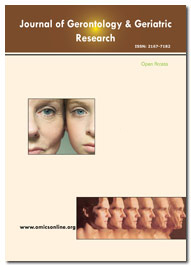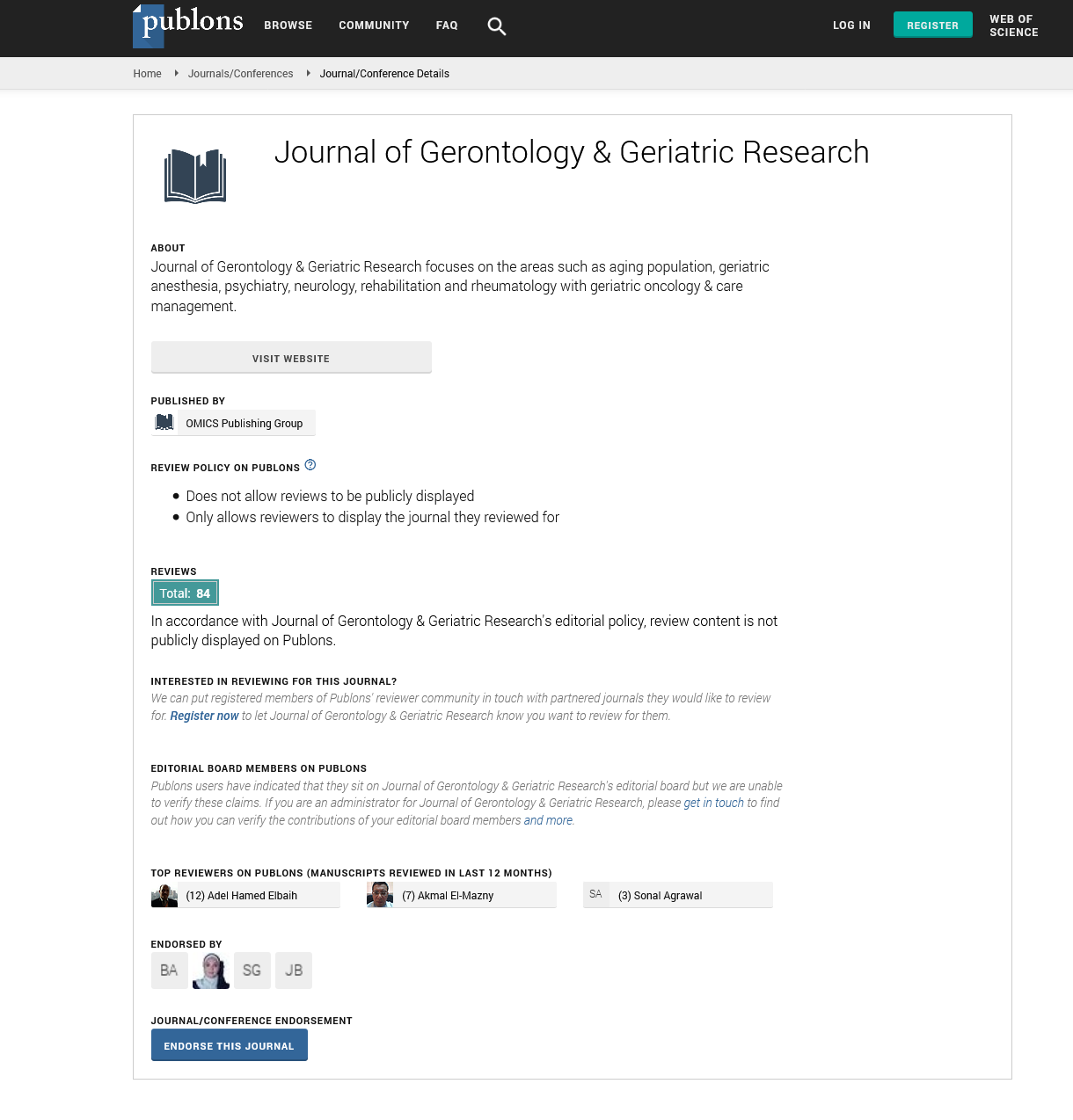Indexed In
- Open J Gate
- Genamics JournalSeek
- SafetyLit
- RefSeek
- Hamdard University
- EBSCO A-Z
- OCLC- WorldCat
- Publons
- Geneva Foundation for Medical Education and Research
- Euro Pub
- Google Scholar
Useful Links
Share This Page
Journal Flyer

Open Access Journals
- Agri and Aquaculture
- Biochemistry
- Bioinformatics & Systems Biology
- Business & Management
- Chemistry
- Clinical Sciences
- Engineering
- Food & Nutrition
- General Science
- Genetics & Molecular Biology
- Immunology & Microbiology
- Medical Sciences
- Neuroscience & Psychology
- Nursing & Health Care
- Pharmaceutical Sciences
Brief Report - (2024) Volume 13, Issue 6
Functional Limitations and Quality of Life in Seniors with Depression: A Comprehensive Review
Henrique Ebranches**Received: 04-Dec-2024, Manuscript No. jggr-25-28285; Editor assigned: 06-Dec-2024, Pre QC No. P-28285; Reviewed: 18-Dec-2024, QC No. Q-28285; Revised: 24-Dec-2024, Manuscript No. R-28285; Published: 31-Dec-2024, DOI: 10.35248/2167-7182.2024.13.769
INTRODUCTION
As the global population continues to age, the prevalence of depression among older adults is becoming a significant public health concern. Depression not only affects mental health but also has profound impacts on the overall quality of life and functionality of older individuals. This comprehensive analysis aims to delve into the intricate relationship between depression, quality of life, and functionality in older adults, exploring the challenges they face and potential interventions to enhance their well-being. Depression is not a normal part of aging [1], yet it is a prevalent mental health issue among older adults. Factors such as the loss of loved ones, chronic health conditions, and social isolation can contribute to the development of depression in this population. Depression often goes unnoticed or is dismissed as a natural consequence of aging, leading to underdiagnosis and under treatment.
DESCRIPTION
Social isolation is a common issue among older adults with depression. The loss of friends and family members, combined with limited mobility, can lead to decreased social interactions. As a result, individuals may feel disconnected from their communities, leading to feelings of loneliness and further exacerbating their depressive symptoms. The living environment plays a crucial role in the quality of life of older adults. Depression can lead to neglect of one's surroundings, creating an unsafe or unsupportive living environment. This, in turn, can worsen depression and reduce overall wellbeing. A Complex Interplay Functionality refers to an individual's ability to perform Activities of Daily Living (ADLs) and Instrumental Activities of Daily Living (IADLs). ADLs include basic self-care tasks such as bathing, dressing, and eating, while IADLs involve more complex activities like managing finances and medication [2]. There is a persistent stigma surrounding mental health, particularly among older generations. This stigma can prevent individuals from seeking help or discussing their feelings openly. Depression symptoms in older adults can be misattributed to other conditions, such as dementia or normal aging. Healthcare providers may also overlook mental health concerns during routine visits. Older adults, especially those in rural areas, may have limited access to mental health services. Additionally, mobility issues can make it difficult for them to attend therapy sessions or support groups. Some older adults may have grown up in a time when mental health issues were rarely discussed openly. This generational attitude can discourage them from acknowledging their own mental health struggles [3-5].
CONCLUSION
Depression in older adults is a multifaceted issue with significant impacts on both quality of life and daily functioning. Tackling this challenge necessitates a comprehensive approach that combines mental health care, social support, and functional interventions. By acknowledging the specific difficulties faced by older individuals dealing with depression and implementing well-rounded strategies, society can greatly improve their well-being and enhance their overall quality of life.
REFERENCES
1. Asady E, Ghanima W, Jelsnessâ?Jorgensen LP, Klok FA, Kahn SR, Stromme H, et al. Healthâ?related qualityâ?ofâ?life questionnaires for deep vein thrombosis and pulmonary embolism: A systematic review on questionnaire development and methodology. Research and Practice in Thrombosis and Haemostasis. 2021; 5:12556.
2. Tavoly M, Utne KK, Jelsness-Jørgensen LP, Wik HS, Klok FA, Sandset PM, et al. Health-related quality of life after pulmonary embolism: A cross-sectional study. BMJ open 2016; 6: 013086.
Citation: Ebranches H (2024) Functional Limitations and Quality of Life in Seniors with Depression: A Comprehensive Review. J Gerontol Geriatr Res.13: 769.
Copyright: © 2024 Ebranches H. This is an open-access article distributed under the terms of the Creative Commons Attribution License, which permits unrestricted use, distribution, and reproduction in any medium, provided the original author and source are credited.

